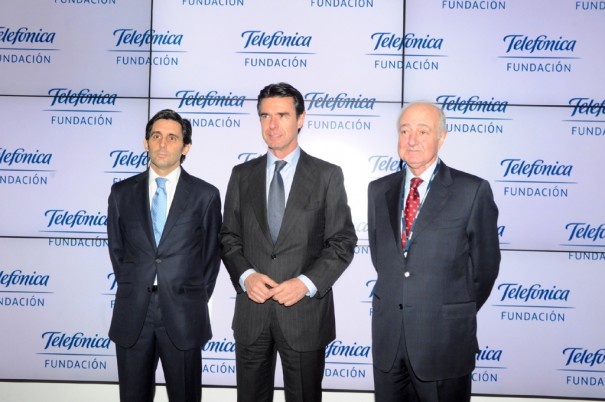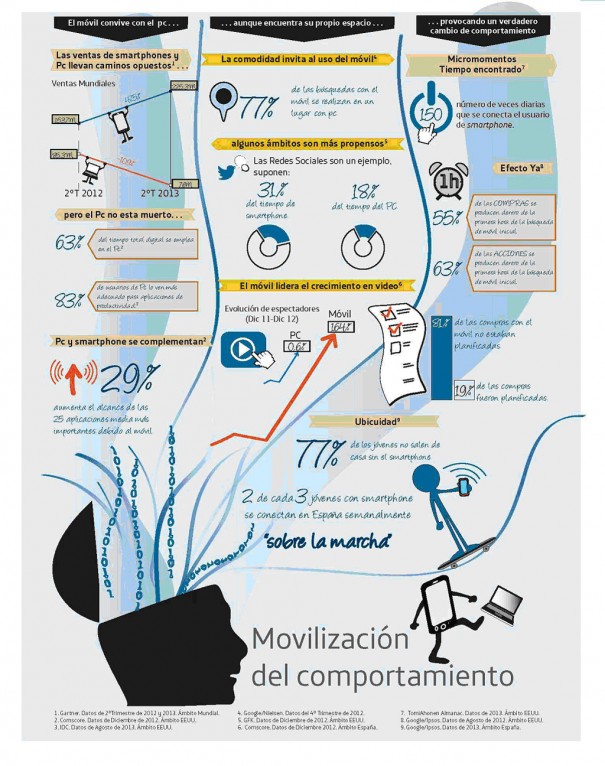Digital life is consolidated in Spanish society with 19 millions of citizens connected to the Internet
The fourteenth edition of the report 'The Information Society in Spain', corresponding to 2013, provides an overview of trends and megatrends in the ICT sector. A year marked by the consolidation of mobility and the change in user behaviour in their digital lives. Near 19 millions of Spaniards live connected to the Internet.
The Telefónica Foundation has published the report 'The Information Society in Spain’ corresponding to the year 2013, at an event presided over by the Minister of Industry, Tourism and Commerce, Jose Manuel Soria, José María Álvarez-Pallete, CEO of Telephone, and the Executive Vice President of Telefónica Foundation, Emilio Gilolmo.
According to the report, the year 2013 has been characterized by the unstoppable advance of the demand for ICT services in a difficult macroeconomic context. This consolidation of digital life in Spain shows that the 71,6% of citizens, two points more than in 2012, had accessed the Internet in the last three months. the 69,8% of households has an Internet connection and the 75% Connects every day.
However, the connection to the Internet is increasingly made outside the usual home or workplace (69,9% of users). The most commonly used device to access the Internet on the go is the phone, with the 63,2 percent, followed by laptops (including netbooks and tablets), with the 31,6 and the rest (PDAs, Consoles, Etc.) with the 6,3%. The number of smartphones continues to grow and there are already almost as many mobile phones in the world (6.800 Million) as people (7.100 Million).
In absolute terms, 24,8 millions of Spaniards between 16 and 74 years connect to the Internet, 700.000 users more than a year earlier.
This study, Presented annually, reflects the digital evolution in Spain, An evolution "has led us to the current state we are living in and which is a real revolution, since ICT knowledge is essential for personal and professional development", comments Emilio Gilolmo.
The report includes the current and future trends of the digital society and Álvarez Pallete classifies them as "megatrends, future trends and realities".
One of the first three megatrends is that ICTs have transformed the microeconomy. "In 2013 we have seen how the Internet has begun to be used to share goods (Sharing Economy), Funding projects through small grants (Crowdfunding) and mechanisms are appearing to make payments of small amounts, with operator billing being one of the most relevant services", comments Pallet.
The second megatrend is the mobilization of behavior. Connection on the go, increasingly used, makes mobile broadband the engine of the advancement of the Information Society and adds 9,5 million new users in the last year. In addition, The mobile phone is consulted an average of 150 times per day per user. "This makes us change the way we act on a day-to-day basis".
and, last, the third is the so-called Pervasive Computing. "Computing is running all around us in the right place, depending on the context and capability of each device.
When it comes to future trends, the Internet of Things (IoE) It is beginning to occupy a priority place in society and has entered the personal sphere. It is estimated that in 2016 80 Millions of Fitness Tracking Devices Will Be Sold.
In addition, digitalization has reached a second phase where 3D printing is taking center stage, Big Data, Open Hardware and Cloud Manufacturing.
In education, Digitalization is being strongly introduced, changing the training model "facilitating students' access to a large number of educational content. Two out of eight students have a computer. Spain is making a great effort in this field and has launched different initiatives such as the Digital Backpack. Pilot experiments have already been carried out in Castilla La Mancha and we hope that during this year it will be extended to the rest of the territory", clarifies Pallete.
Digital Realities
When it comes to digital realities, 2013 It has been characterized by the proliferation of mobile devices and the consolidation of this technology both at a personal level and in companies. In addition, Operators with their own network have deployed their fourth-generation networks (LTE) and have launched convergent offerings to make these services more accessible. – Although 2013 it's been the year of 4G, Fiber optics is the fastest growing technology. Almost 9 of each 10 New Ultra-Fast Network Accesses Are Fiber.
Another trend that has taken hold over the past few years 2013 It has been the signing of agreements between operators to share infrastructures and be able to be more efficient. A strategy that responds to a complex economic situation.
 Online TV has also had a strong boost in the last year. in 2013, the 24% of Internet users have connected to the Internet through television, what is a 33% more about 2012. In addition, Online TV is becoming multi-device and coming to live events. The user accesses the multimedia content anywhere, Inside and outside the home.
Online TV has also had a strong boost in the last year. in 2013, the 24% of Internet users have connected to the Internet through television, what is a 33% more about 2012. In addition, Online TV is becoming multi-device and coming to live events. The user accesses the multimedia content anywhere, Inside and outside the home.
The Administration, health and education are the areas of activity where the use of the Internet is increasing its impact on citizens. more than 365 millions of procedures with the General State Administration were registered electronically at 2012, one 66% of the total and 4 points more than a year earlier. This allowed Spain to be above the European average for the first time in terms of the number of users of the eAdministration, with a 45% of citizens who interacted with Public Administrations through the Internet.
Administrations and governments are directing their strategies towards the implementation of a digital economy. This was highlighted by José Manuel Soria, Minister of Industry, Energy and Tourism, who highlighted in his speech the importance that the Government attaches to ICTs and highlighted some of the initiatives carried out by the Executive such as the Digital Agenda, The General Telecommunications Law or the Law on Support for Entrepreneurs and their Internationalization. "The challenge that the Administration has set itself is to create a stable and adequate framework that will allow us to achieve this digital economy".
[youtube]HTTP://www.youtube.com/watch?v=x04yi6ufv4Q[/youtube]
You liked this article?
Subscribe to our RSS feed And you won't miss anything.
• section: display, Signal distribution, Studies, formation, Infrastructure, business, networks, Bless you




